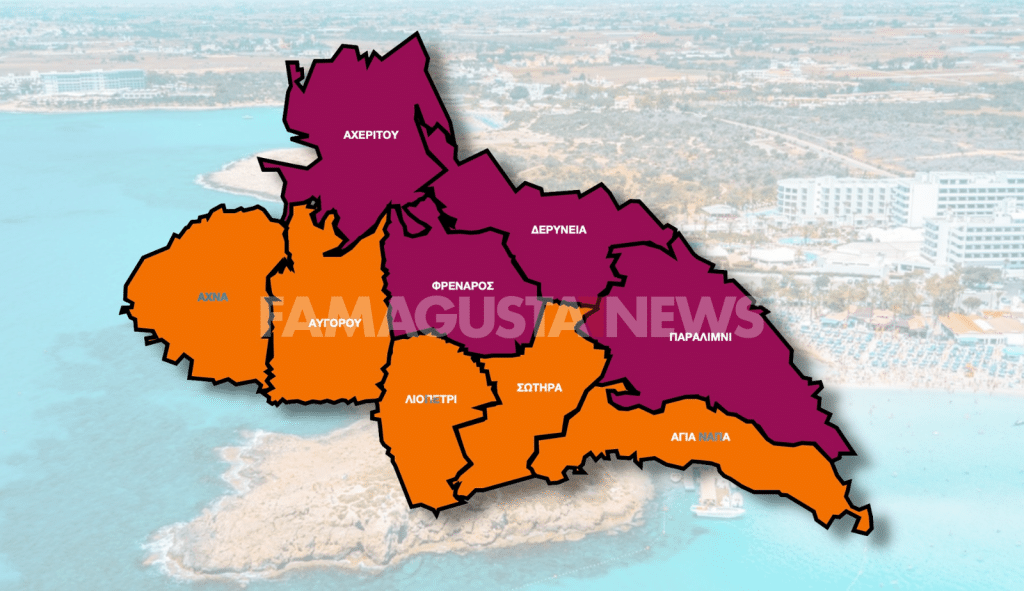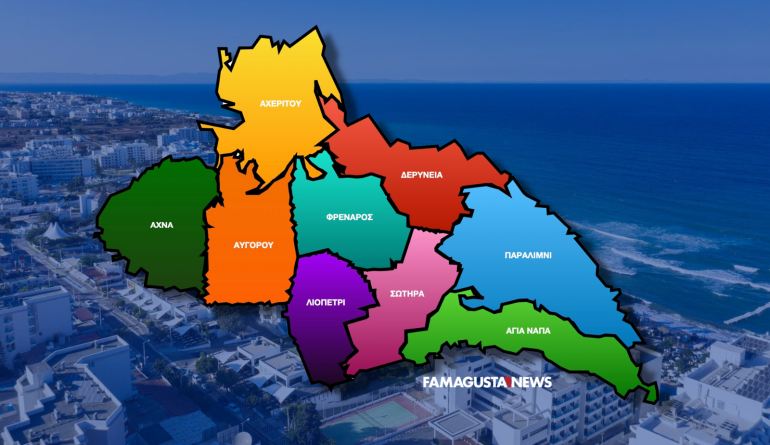From 2024, the Local Self-Government in Cyprus enters a new trajectory after the elections which will be held together with the European elections in June 9 2024 and they will highlight the first local officials after the reform proposed by the Government of Nikos Anastasiadis with the aim of reducing the number of Municipalities and Communities, mainly through mergers.
The changes in the province of Famagusta
Based on the reform of the Local Government, in the province of Famagusta the Temporary District Council of Famagusta has already been established, whose temporary President has been appointed by the approval of the bill, the Mayor of Paralimni, Theodoros Pyrillis, while the 4 Municipalities and the 5 Communities are merged into 2 Municipalities:
- Municipality of Paralimni Deryneia
- Paralimni
- Derynia
- Frenaros
- Acheritou
- Municipality of Ayia Napa
- Αγία Νάπα
- Sotira
- Liopetri
- Avgorou
- Achna

District Councils
Composition and elections
Based on the Provincial Self-Government Organizations Law of 2022 (37(I)/2022), the Provincial Councils will be composed of the President and 16 members, including the Vice President, 10 of whom come from the relevant Municipal Councils and 6 from the local Community Councils. The members are elected by a general assembly in which the Municipal and Community Councils are represented, depending on the election. Municipalities and communities are represented in general assemblies by all mayors and all community leaders, as well as by members of municipal councils and community councils, based on the applicable population ratio. The President of the Provincial Council is elected through an electoral process in which the registered voters of the district of the Provincial Council participate.
- Chairman
- 10 members from Municipal Councils
- 6 members from Community Councils
In the case of the province of Famagusta there will be no Community Councils, since with the mergers of the local authorities, 2 Municipalities will remain.
Responsibilities
- Environmental planning and management,
- Issuance of Town Planning Permits,
- Construction, maintenance and operation of water supply systems,
- construction, maintenance and operation of drainage systems for liquid sewage and rainwater,
- construction, maintenance and operation of waste management facilities,
- Responsibilities of the Water Supply Board,
- Responsibilities of the Sewerage Board,
- Responsibilities of the Council for the Exploitation of Places for the Disposal or Utilization of Household Waste.

Municipalities
Each council consists of the mayor, the vice-mayors and the councilors, who are elected by the citizens electors, by virtue of the provisions of the Law.
A deputy mayor participates in each council for each municipal district of those that make up the relevant municipality.
The number of councilors participating in the council, including the vice-mayors, cannot be less than sixteen (16) and more than thirty (30), as specifically provided below:
- In municipalities whose voters do not exceed ten thousand (10.000): 16 councilors,
- in municipalities whose voters exceed ten thousand (10.000), but do not exceed twenty thousand (20.000): 20 councilors,
- in municipalities whose voters exceed twenty thousand (20.000), but do not exceed thirty thousand (30.000): 24 councilors,
- in municipalities whose voters exceed thirty thousand (30.000): 30 councillors.
It is provided that, in case of declaration of communities in a municipality or in a municipal district, if the number of councilors provided for, including the deputy mayor, is not at least twice the number of municipal districts that make up the municipality, the Council of Ministers has the power to determine the number of councilors of the municipality in question and/or the municipal apartments that make up the municipality.
The mayor, vice-mayors and other members of the council are elected by the municipal electors, either by general election or by alternate election, as the case may be.
The mayor of each municipality is elected, by all the municipal electors of the municipality, separately, on the same date on which elections are held to nominate the other councilors and, after these elections, the candidate who receives the most valid votes from the citizens electors of the municipality concerned.
The deputy mayor candidate who collects the largest number of votes in the municipal district from the citizen voters of the relevant municipal district is elected as deputy mayor:
The filling of the positions of councilors in the municipal districts begins with the performance of one (1) position in each municipal district and the rest of the seats are distributed among the municipal districts according to the number of voters in each municipal district:
If it follows from the above distribution that one (1) position is allocated to a specific municipal district, this is occupied by the deputy mayor of the relevant municipal district:
In the event that a municipal district has one (1) vice-mayor position and any remainder is not sufficient to elect another municipal councilor, this is not taken into account in the calculation of the electoral measure.
Famagusta.News
